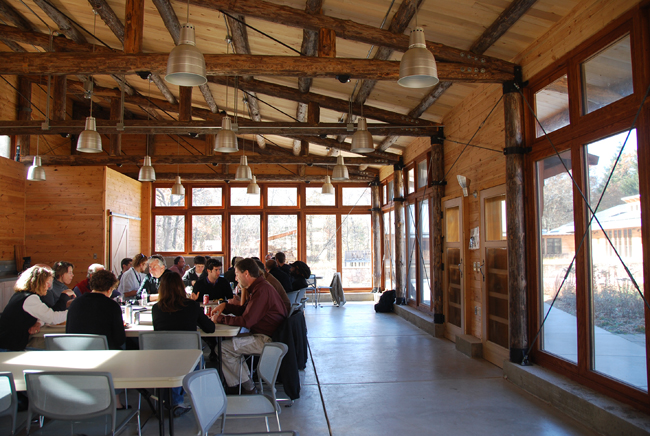#1 - REDUCE LOADS / DEMAND FIRST
This must be the starting point for any carbon neutral design. If the building is not carefully designed to lessen its impact (material and energy requirements) from the outset, it will NOT be possible to provide adequate renewable energy to allow the building to operate.
REINVENTING THE PROGRAM:
From the outset of the project it will be necessary to rethink the scope of the building (size and height). The smaller the building the smaller its carbon footprint and lower the amount of energy to operate. This might not simply infer a reduction in square footage, but a thorough reinvention of the program. Questions will need to be asked that rank the relative importance of spaces and offer the possibility of doubling up on program needs to make better daily or seasonal use of program functions.
This reinvention of the program, particularly when it may begin to look at the reduction of the scope and size of the program, admittedly presents current practice with a level of conflict. If the fees for a project are levied as a percentage of the construction cost, this might negatively impact the fees paid for the project. It will be even more important to use an Integrated Design Process to ensure that the client and consultants are part of the overall strategy and buy-in to the Carbon Neutral Design process. The fee structure might need to be altered to ensure payment for an increased level of engineering, detailed design, energy simulation and specialized systems. One point of client negotiation should be the reduction in permanent operating costs resulting from the more efficient design of the building.

Aldo Leopold Legacy Center - 3 Season Room
It was decided that this large multi purpose room was only really necessary to the program in the Spring, Summer and Fall. When it was chilly, it could be heated with a wood stove. The large areas of glazing allowed for direct thermal gain to heat the concrete floors. Large operable windows could be used for ventilation in the hot summer months. |
BACK TO BASICS THINKING:
Carbon Neutral Design requires holistic and synergistic thinking. Carbon Neutral Design cannot be achieved through "checklist thinking". The majority of LOAD REDUCTION will be achieved through proper attention to the local climate, orientation, siting and massing of the building.
Significant load reduction requires a back to basics thinking that positions the climate, shape and materiality of the building at the core of the problem. Carbon neutral design requires a back to basics thinking in passive design terms with deference to the use of natural systems to heat and cool the building.
Relating the site to issues of ORIENTATION and MASSING will begin to impact the way that programmatic requirements may be accommodated in the building. Certain uses may be able to take better advantage of passive heating and cooling if they are located according to site and exterior landscaping characteristics. The choice of landscape materials must be used to modify the local microclimate to assist in passively heating and cooling the building.
DAYLIGHTING will greatly assist in reducing energy costs as well as provide a higher sense of well being to the occupants. The consideration of local site conditions may help to determine the placement of daylit versus non daylit or service spaces. Effective daylighting requires the implementation of a "thin plan" so that all spaces will have access to natural light.
The CROSS SECTIONAL CHARACTERISTICS and BUILDING HEIGHT may also need to be modified to feed into lower energy, natural solutions. The cross section will impact the ability to use stack effect to accelerate air flow through the building. Open plans work better with natural ventilation strategies.
Synergies may be possible when looking at spaces that have larger mechanical or cooling requirements, where waste heat may be able to be used to provide heat transfer to atria or circulations spaces that can make do with a lower level of constant comfort.
Issues such as these are not to be found on any “checklist”, but greatly impact the overall environmental performance and energy requirements of the building.
HIGHLY RECOMMENDED TEXTS FOR PASSIVE DESIGN (written by SBSE members!):
Heating, Cooling, Lighting: Sustainable Design Methods for Architects. Third Edition. Norbert Lechner.
Mechanical and Electrical Equipment for Buildings. Benjamin Stein, John Reynolds, Walter Grondzik, Alison Kwok.
Sun, Wind and Light: Architectural Design Strategies. Second Edition. G. Z. Brown and Mark DeKay.
The Green Studio Handbook: Environmental Strategies for Schematic Design. Walter Grondzik and Alison Kwok.
|

